Electric Car Charging Infrastructure: Implementation Proposal Analysis
VerifiedAdded on 2020/05/16
|10
|1873
|217
Report
AI Summary
This report addresses the challenges faced by electric car drivers regarding charging their vehicles while on the road. It proposes the implementation of a mobile charging infrastructure, specifically focusing on the installation of level 3 chargers in gas stations and along highways to ensure the smooth operation of electric vehicles. The report emphasizes the environmental benefits of electric cars and advocates for government involvement in enhancing their adoption. It includes a detailed cost-benefit analysis, considering development, operating, and maintenance costs, to demonstrate the economic viability and positive impact of the proposed infrastructure. The analysis highlights the significant net present value and benefit-cost ratio, suggesting that the project is beneficial for both the government and the public, ultimately contributing to a more sustainable transportation system. The report concludes by emphasizing the importance of a well-planned infrastructure for electric car users and recommends the implementation of various charger levels to meet diverse needs.
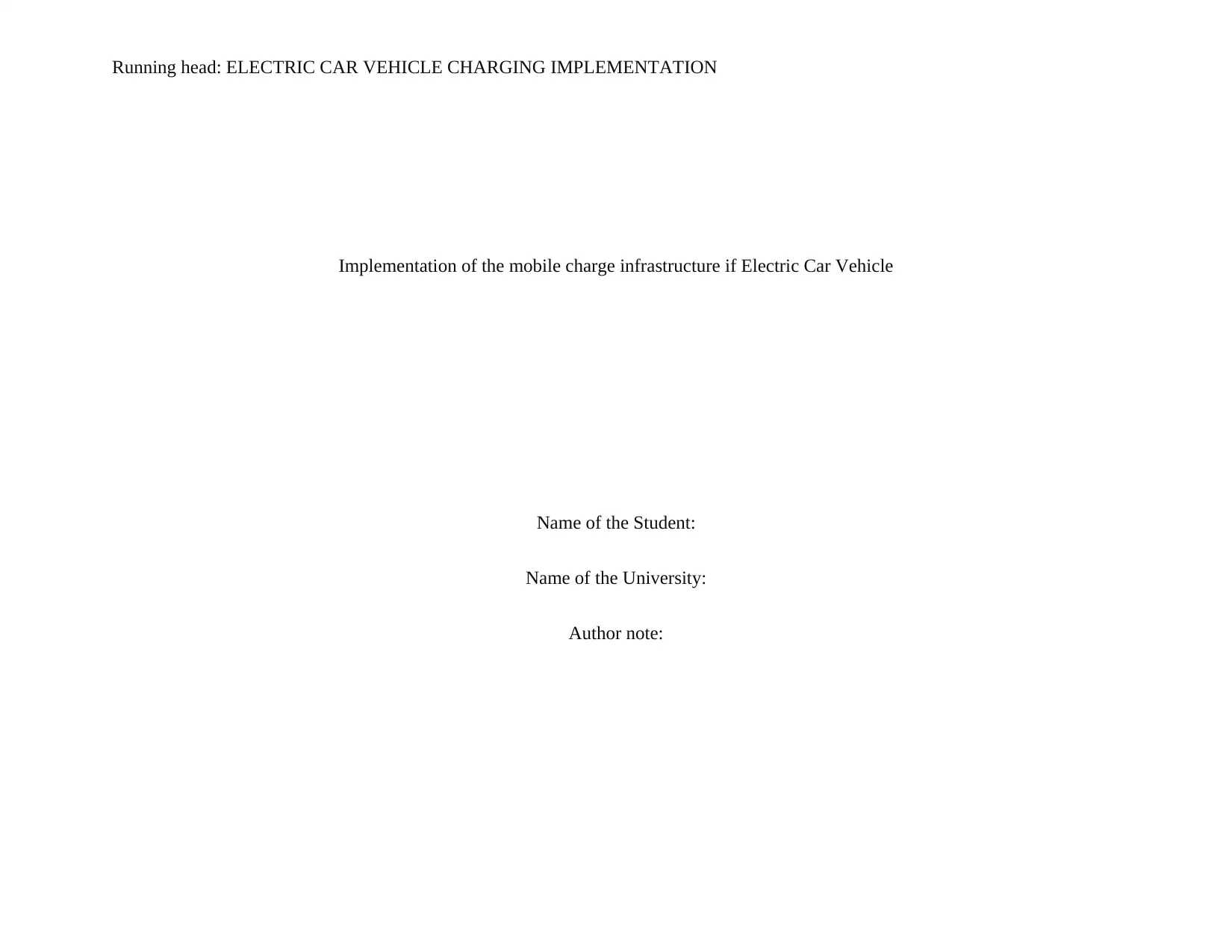
Running head: ELECTRIC CAR VEHICLE CHARGING IMPLEMENTATION
Implementation of the mobile charge infrastructure if Electric Car Vehicle
Name of the Student:
Name of the University:
Author note:
Implementation of the mobile charge infrastructure if Electric Car Vehicle
Name of the Student:
Name of the University:
Author note:
Paraphrase This Document
Need a fresh take? Get an instant paraphrase of this document with our AI Paraphraser
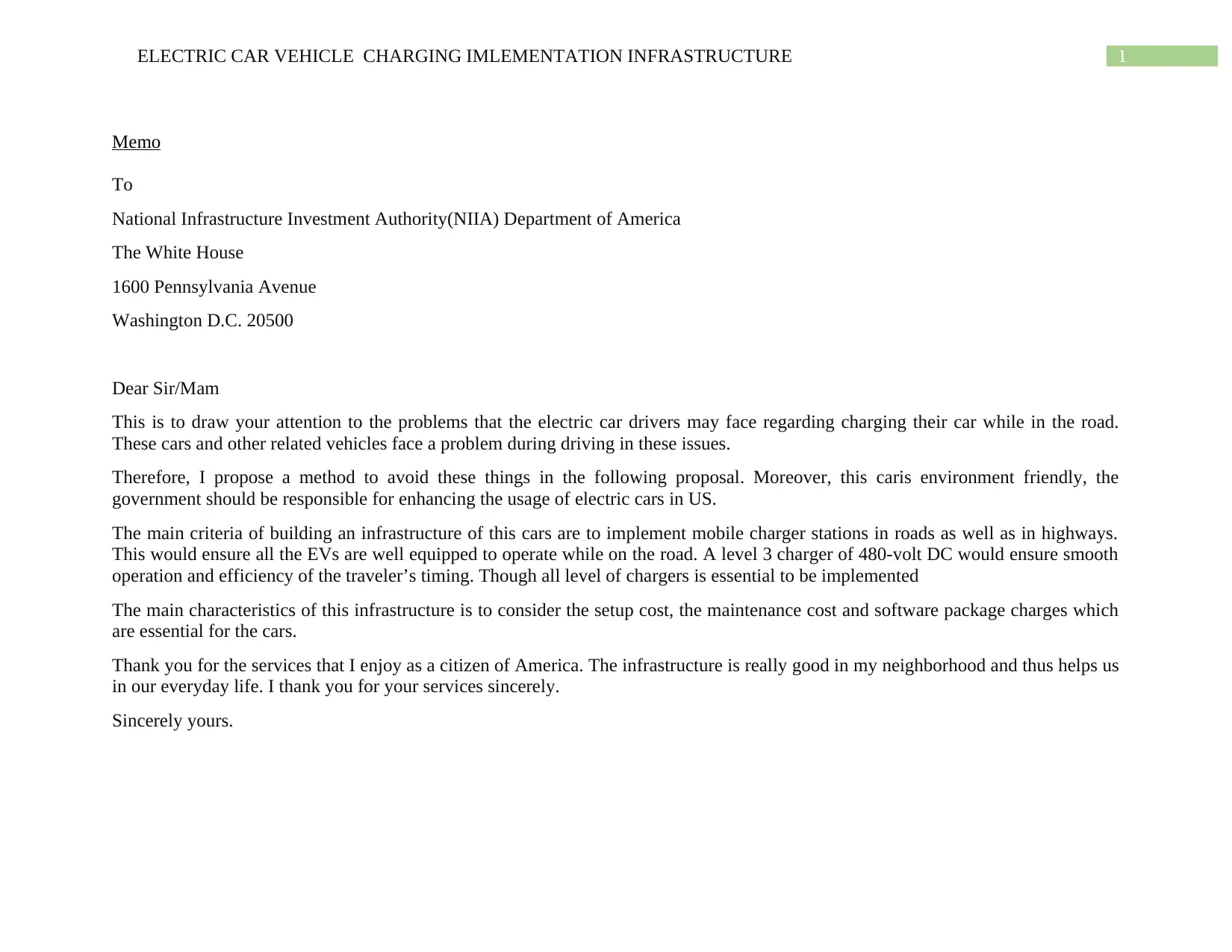
1ELECTRIC CAR VEHICLE CHARGING IMLEMENTATION INFRASTRUCTURE
Memo
To
National Infrastructure Investment Authority(NIIA) Department of America
The White House
1600 Pennsylvania Avenue
Washington D.C. 20500
Dear Sir/Mam
This is to draw your attention to the problems that the electric car drivers may face regarding charging their car while in the road.
These cars and other related vehicles face a problem during driving in these issues.
Therefore, I propose a method to avoid these things in the following proposal. Moreover, this caris environment friendly, the
government should be responsible for enhancing the usage of electric cars in US.
The main criteria of building an infrastructure of this cars are to implement mobile charger stations in roads as well as in highways.
This would ensure all the EVs are well equipped to operate while on the road. A level 3 charger of 480-volt DC would ensure smooth
operation and efficiency of the traveler’s timing. Though all level of chargers is essential to be implemented
The main characteristics of this infrastructure is to consider the setup cost, the maintenance cost and software package charges which
are essential for the cars.
Thank you for the services that I enjoy as a citizen of America. The infrastructure is really good in my neighborhood and thus helps us
in our everyday life. I thank you for your services sincerely.
Sincerely yours.
Memo
To
National Infrastructure Investment Authority(NIIA) Department of America
The White House
1600 Pennsylvania Avenue
Washington D.C. 20500
Dear Sir/Mam
This is to draw your attention to the problems that the electric car drivers may face regarding charging their car while in the road.
These cars and other related vehicles face a problem during driving in these issues.
Therefore, I propose a method to avoid these things in the following proposal. Moreover, this caris environment friendly, the
government should be responsible for enhancing the usage of electric cars in US.
The main criteria of building an infrastructure of this cars are to implement mobile charger stations in roads as well as in highways.
This would ensure all the EVs are well equipped to operate while on the road. A level 3 charger of 480-volt DC would ensure smooth
operation and efficiency of the traveler’s timing. Though all level of chargers is essential to be implemented
The main characteristics of this infrastructure is to consider the setup cost, the maintenance cost and software package charges which
are essential for the cars.
Thank you for the services that I enjoy as a citizen of America. The infrastructure is really good in my neighborhood and thus helps us
in our everyday life. I thank you for your services sincerely.
Sincerely yours.
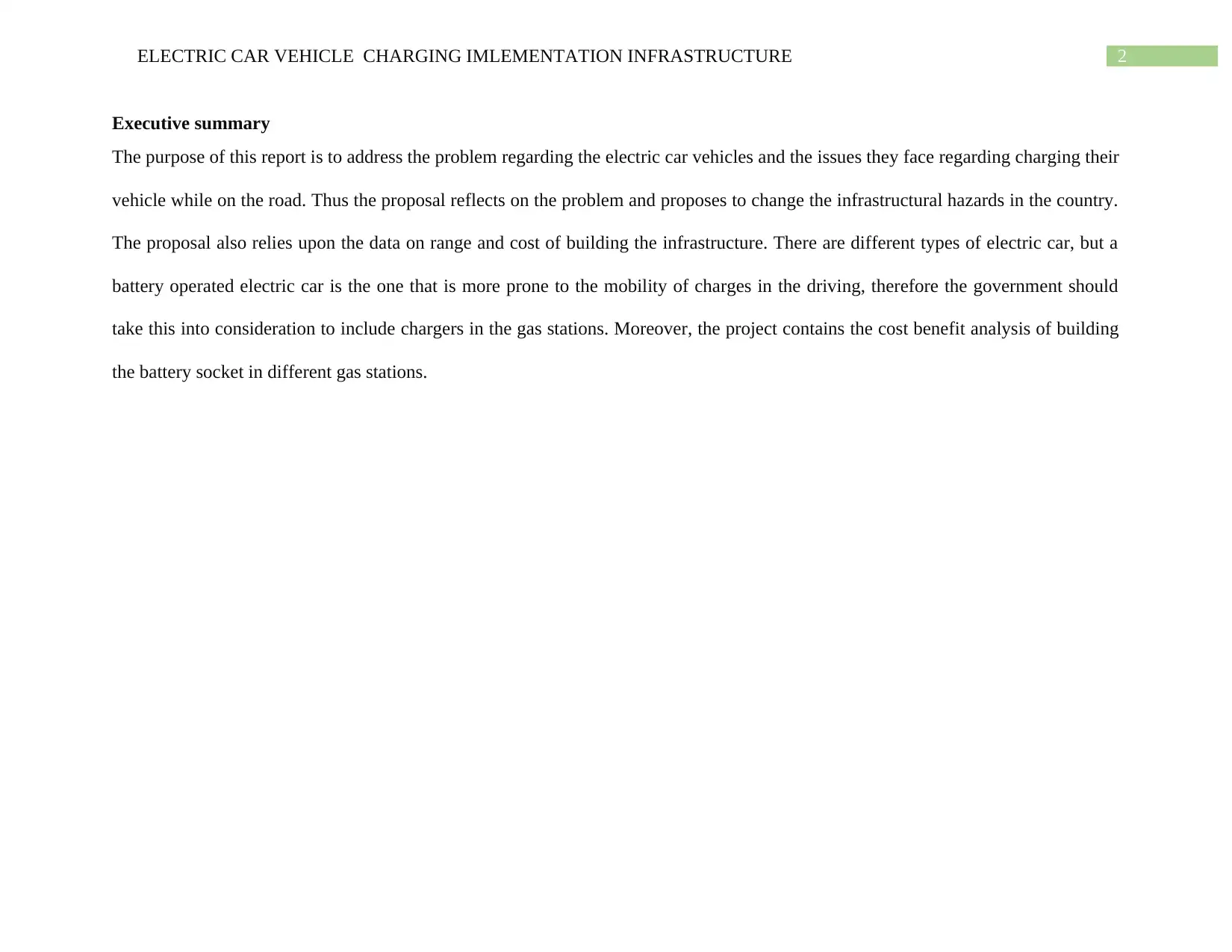
2ELECTRIC CAR VEHICLE CHARGING IMLEMENTATION INFRASTRUCTURE
Executive summary
The purpose of this report is to address the problem regarding the electric car vehicles and the issues they face regarding charging their
vehicle while on the road. Thus the proposal reflects on the problem and proposes to change the infrastructural hazards in the country.
The proposal also relies upon the data on range and cost of building the infrastructure. There are different types of electric car, but a
battery operated electric car is the one that is more prone to the mobility of charges in the driving, therefore the government should
take this into consideration to include chargers in the gas stations. Moreover, the project contains the cost benefit analysis of building
the battery socket in different gas stations.
Executive summary
The purpose of this report is to address the problem regarding the electric car vehicles and the issues they face regarding charging their
vehicle while on the road. Thus the proposal reflects on the problem and proposes to change the infrastructural hazards in the country.
The proposal also relies upon the data on range and cost of building the infrastructure. There are different types of electric car, but a
battery operated electric car is the one that is more prone to the mobility of charges in the driving, therefore the government should
take this into consideration to include chargers in the gas stations. Moreover, the project contains the cost benefit analysis of building
the battery socket in different gas stations.
⊘ This is a preview!⊘
Do you want full access?
Subscribe today to unlock all pages.

Trusted by 1+ million students worldwide
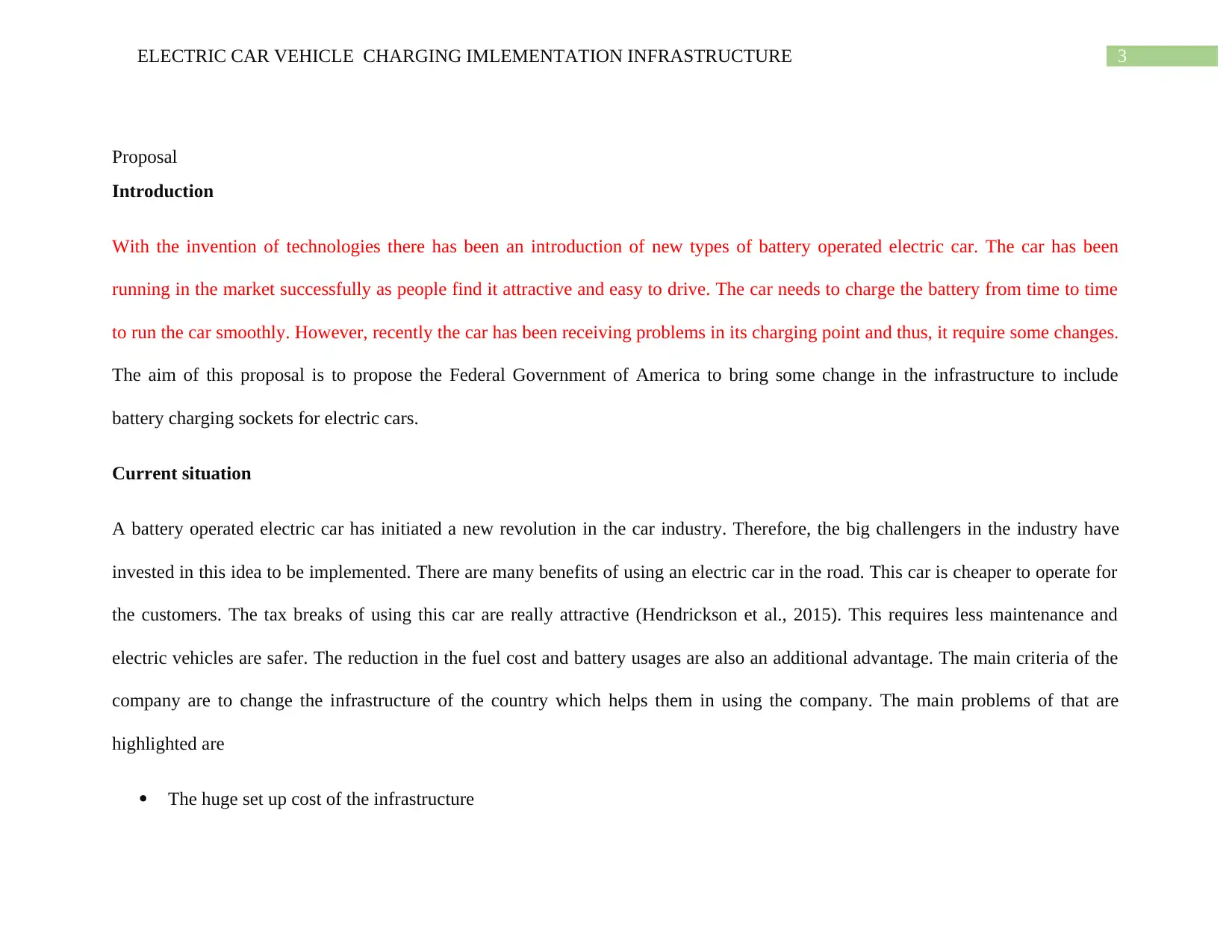
3ELECTRIC CAR VEHICLE CHARGING IMLEMENTATION INFRASTRUCTURE
Proposal
Introduction
With the invention of technologies there has been an introduction of new types of battery operated electric car. The car has been
running in the market successfully as people find it attractive and easy to drive. The car needs to charge the battery from time to time
to run the car smoothly. However, recently the car has been receiving problems in its charging point and thus, it require some changes.
The aim of this proposal is to propose the Federal Government of America to bring some change in the infrastructure to include
battery charging sockets for electric cars.
Current situation
A battery operated electric car has initiated a new revolution in the car industry. Therefore, the big challengers in the industry have
invested in this idea to be implemented. There are many benefits of using an electric car in the road. This car is cheaper to operate for
the customers. The tax breaks of using this car are really attractive (Hendrickson et al., 2015). This requires less maintenance and
electric vehicles are safer. The reduction in the fuel cost and battery usages are also an additional advantage. The main criteria of the
company are to change the infrastructure of the country which helps them in using the company. The main problems of that are
highlighted are
The huge set up cost of the infrastructure
Proposal
Introduction
With the invention of technologies there has been an introduction of new types of battery operated electric car. The car has been
running in the market successfully as people find it attractive and easy to drive. The car needs to charge the battery from time to time
to run the car smoothly. However, recently the car has been receiving problems in its charging point and thus, it require some changes.
The aim of this proposal is to propose the Federal Government of America to bring some change in the infrastructure to include
battery charging sockets for electric cars.
Current situation
A battery operated electric car has initiated a new revolution in the car industry. Therefore, the big challengers in the industry have
invested in this idea to be implemented. There are many benefits of using an electric car in the road. This car is cheaper to operate for
the customers. The tax breaks of using this car are really attractive (Hendrickson et al., 2015). This requires less maintenance and
electric vehicles are safer. The reduction in the fuel cost and battery usages are also an additional advantage. The main criteria of the
company are to change the infrastructure of the country which helps them in using the company. The main problems of that are
highlighted are
The huge set up cost of the infrastructure
Paraphrase This Document
Need a fresh take? Get an instant paraphrase of this document with our AI Paraphraser
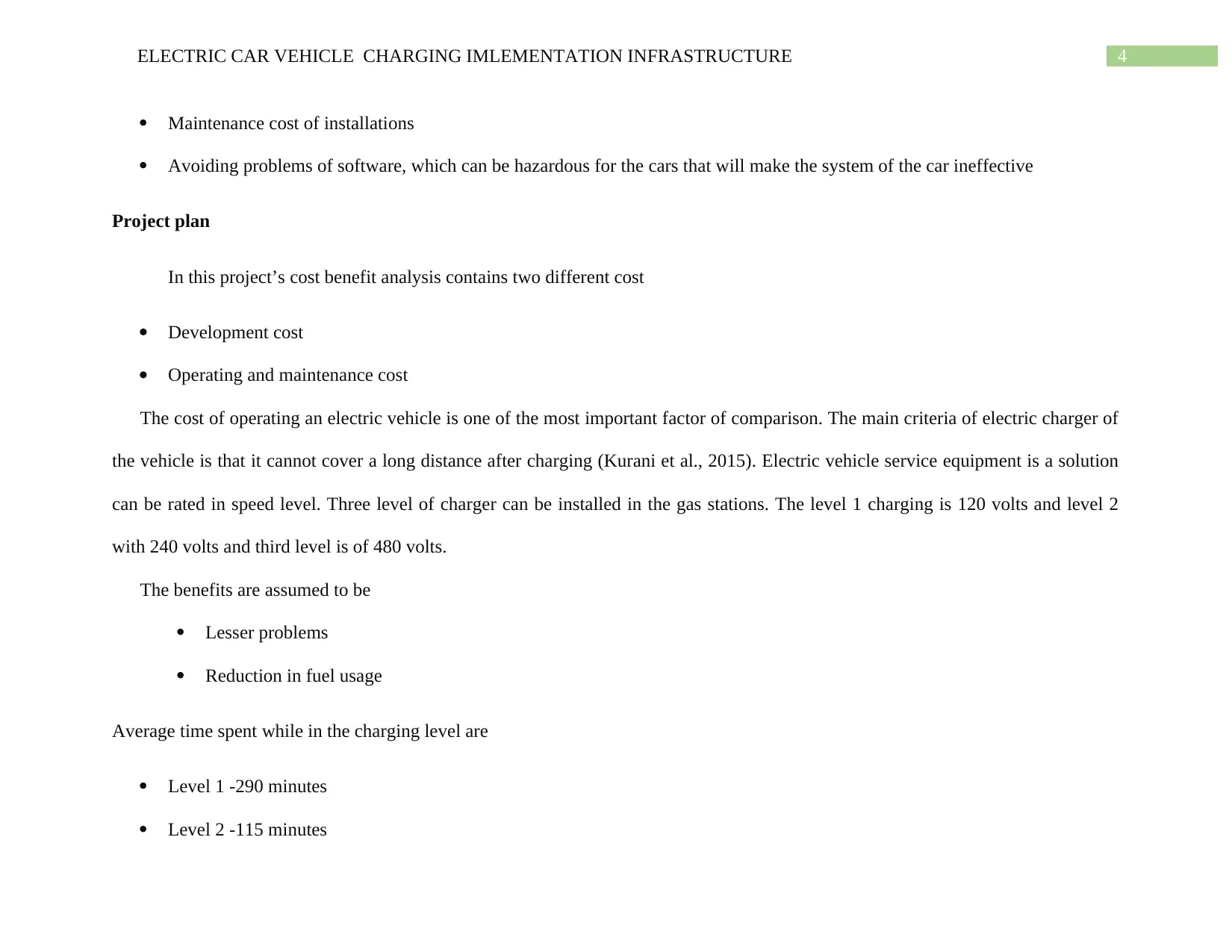
4ELECTRIC CAR VEHICLE CHARGING IMLEMENTATION INFRASTRUCTURE
Maintenance cost of installations
Avoiding problems of software, which can be hazardous for the cars that will make the system of the car ineffective
Project plan
In this project’s cost benefit analysis contains two different cost
Development cost
Operating and maintenance cost
The cost of operating an electric vehicle is one of the most important factor of comparison. The main criteria of electric charger of
the vehicle is that it cannot cover a long distance after charging (Kurani et al., 2015). Electric vehicle service equipment is a solution
can be rated in speed level. Three level of charger can be installed in the gas stations. The level 1 charging is 120 volts and level 2
with 240 volts and third level is of 480 volts.
The benefits are assumed to be
Lesser problems
Reduction in fuel usage
Average time spent while in the charging level are
Level 1 -290 minutes
Level 2 -115 minutes
Maintenance cost of installations
Avoiding problems of software, which can be hazardous for the cars that will make the system of the car ineffective
Project plan
In this project’s cost benefit analysis contains two different cost
Development cost
Operating and maintenance cost
The cost of operating an electric vehicle is one of the most important factor of comparison. The main criteria of electric charger of
the vehicle is that it cannot cover a long distance after charging (Kurani et al., 2015). Electric vehicle service equipment is a solution
can be rated in speed level. Three level of charger can be installed in the gas stations. The level 1 charging is 120 volts and level 2
with 240 volts and third level is of 480 volts.
The benefits are assumed to be
Lesser problems
Reduction in fuel usage
Average time spent while in the charging level are
Level 1 -290 minutes
Level 2 -115 minutes
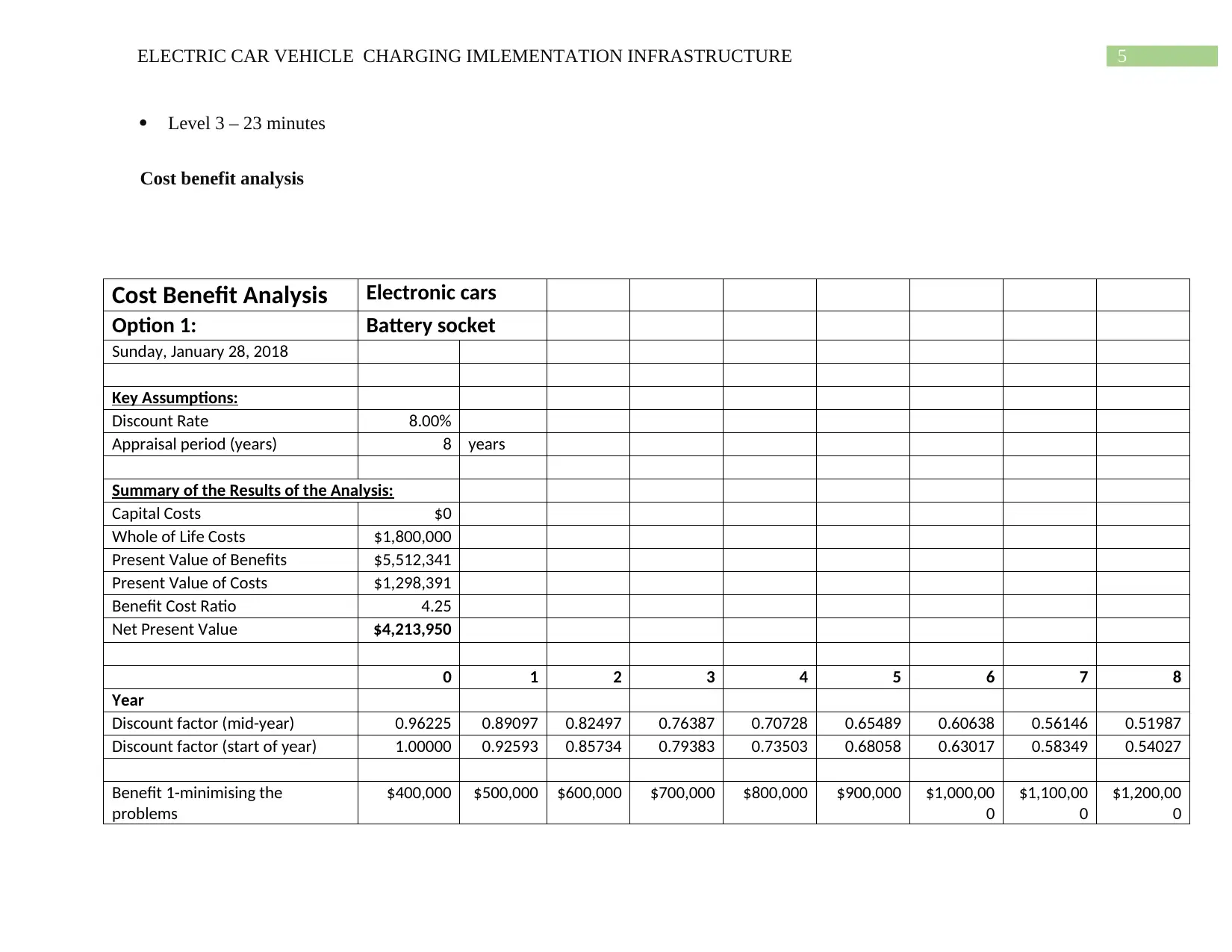
5ELECTRIC CAR VEHICLE CHARGING IMLEMENTATION INFRASTRUCTURE
Level 3 – 23 minutes
Cost benefit analysis
Cost Benefit Analysis Electronic cars
Option 1: Battery socket
Sunday, January 28, 2018
Key Assumptions:
Discount Rate 8.00%
Appraisal period (years) 8 years
Summary of the Results of the Analysis:
Capital Costs $0
Whole of Life Costs $1,800,000
Present Value of Benefits $5,512,341
Present Value of Costs $1,298,391
Benefit Cost Ratio 4.25
Net Present Value $4,213,950
0 1 2 3 4 5 6 7 8
Year
Discount factor (mid-year) 0.96225 0.89097 0.82497 0.76387 0.70728 0.65489 0.60638 0.56146 0.51987
Discount factor (start of year) 1.00000 0.92593 0.85734 0.79383 0.73503 0.68058 0.63017 0.58349 0.54027
Benefit 1-minimising the
problems
$400,000 $500,000 $600,000 $700,000 $800,000 $900,000 $1,000,00
0
$1,100,00
0
$1,200,00
0
Level 3 – 23 minutes
Cost benefit analysis
Cost Benefit Analysis Electronic cars
Option 1: Battery socket
Sunday, January 28, 2018
Key Assumptions:
Discount Rate 8.00%
Appraisal period (years) 8 years
Summary of the Results of the Analysis:
Capital Costs $0
Whole of Life Costs $1,800,000
Present Value of Benefits $5,512,341
Present Value of Costs $1,298,391
Benefit Cost Ratio 4.25
Net Present Value $4,213,950
0 1 2 3 4 5 6 7 8
Year
Discount factor (mid-year) 0.96225 0.89097 0.82497 0.76387 0.70728 0.65489 0.60638 0.56146 0.51987
Discount factor (start of year) 1.00000 0.92593 0.85734 0.79383 0.73503 0.68058 0.63017 0.58349 0.54027
Benefit 1-minimising the
problems
$400,000 $500,000 $600,000 $700,000 $800,000 $900,000 $1,000,00
0
$1,100,00
0
$1,200,00
0
⊘ This is a preview!⊘
Do you want full access?
Subscribe today to unlock all pages.

Trusted by 1+ million students worldwide
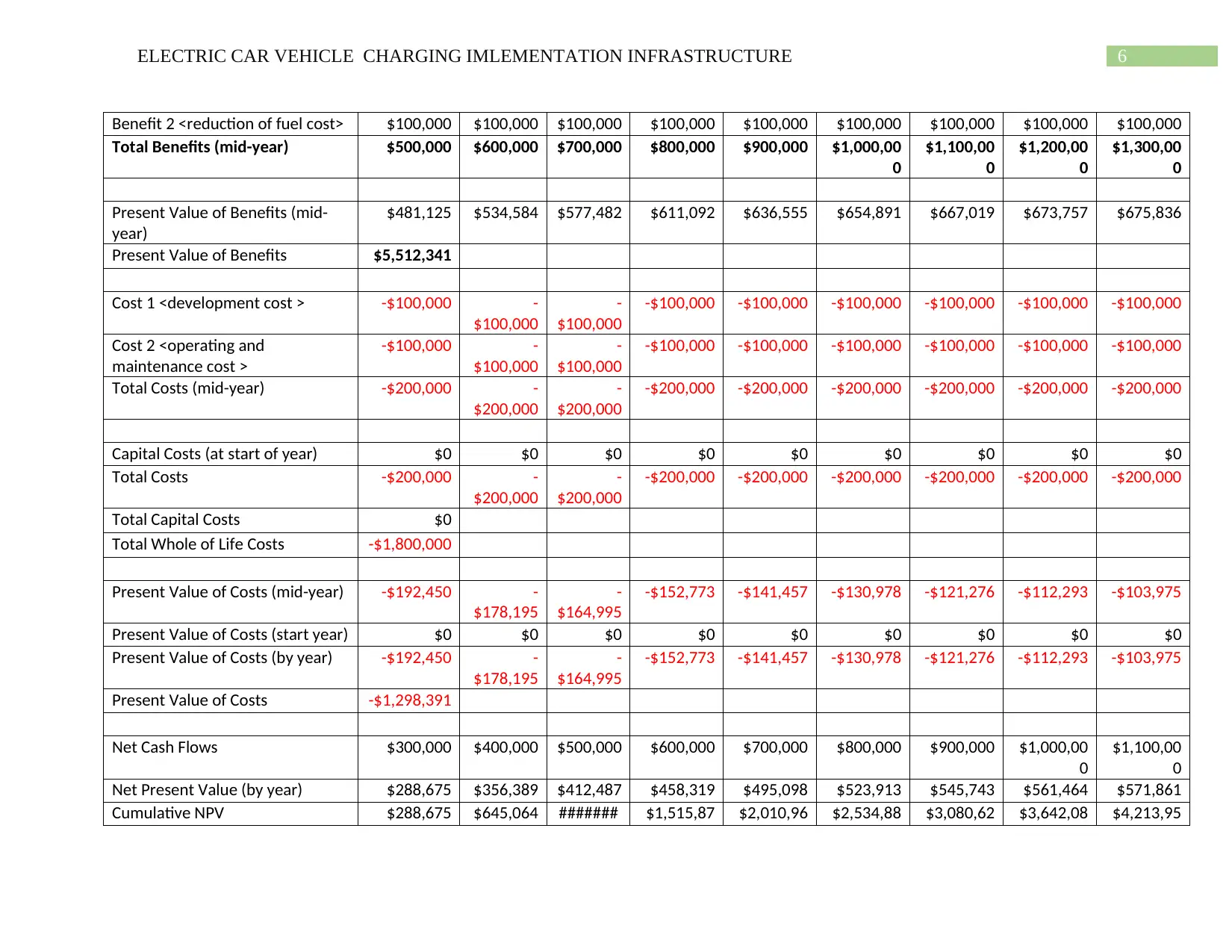
6ELECTRIC CAR VEHICLE CHARGING IMLEMENTATION INFRASTRUCTURE
Benefit 2 <reduction of fuel cost> $100,000 $100,000 $100,000 $100,000 $100,000 $100,000 $100,000 $100,000 $100,000
Total Benefits (mid-year) $500,000 $600,000 $700,000 $800,000 $900,000 $1,000,00
0
$1,100,00
0
$1,200,00
0
$1,300,00
0
Present Value of Benefits (mid-
year)
$481,125 $534,584 $577,482 $611,092 $636,555 $654,891 $667,019 $673,757 $675,836
Present Value of Benefits $5,512,341
Cost 1 <development cost > -$100,000 -
$100,000
-
$100,000
-$100,000 -$100,000 -$100,000 -$100,000 -$100,000 -$100,000
Cost 2 <operating and
maintenance cost >
-$100,000 -
$100,000
-
$100,000
-$100,000 -$100,000 -$100,000 -$100,000 -$100,000 -$100,000
Total Costs (mid-year) -$200,000 -
$200,000
-
$200,000
-$200,000 -$200,000 -$200,000 -$200,000 -$200,000 -$200,000
Capital Costs (at start of year) $0 $0 $0 $0 $0 $0 $0 $0 $0
Total Costs -$200,000 -
$200,000
-
$200,000
-$200,000 -$200,000 -$200,000 -$200,000 -$200,000 -$200,000
Total Capital Costs $0
Total Whole of Life Costs -$1,800,000
Present Value of Costs (mid-year) -$192,450 -
$178,195
-
$164,995
-$152,773 -$141,457 -$130,978 -$121,276 -$112,293 -$103,975
Present Value of Costs (start year) $0 $0 $0 $0 $0 $0 $0 $0 $0
Present Value of Costs (by year) -$192,450 -
$178,195
-
$164,995
-$152,773 -$141,457 -$130,978 -$121,276 -$112,293 -$103,975
Present Value of Costs -$1,298,391
Net Cash Flows $300,000 $400,000 $500,000 $600,000 $700,000 $800,000 $900,000 $1,000,00
0
$1,100,00
0
Net Present Value (by year) $288,675 $356,389 $412,487 $458,319 $495,098 $523,913 $545,743 $561,464 $571,861
Cumulative NPV $288,675 $645,064 ####### $1,515,87 $2,010,96 $2,534,88 $3,080,62 $3,642,08 $4,213,95
Benefit 2 <reduction of fuel cost> $100,000 $100,000 $100,000 $100,000 $100,000 $100,000 $100,000 $100,000 $100,000
Total Benefits (mid-year) $500,000 $600,000 $700,000 $800,000 $900,000 $1,000,00
0
$1,100,00
0
$1,200,00
0
$1,300,00
0
Present Value of Benefits (mid-
year)
$481,125 $534,584 $577,482 $611,092 $636,555 $654,891 $667,019 $673,757 $675,836
Present Value of Benefits $5,512,341
Cost 1 <development cost > -$100,000 -
$100,000
-
$100,000
-$100,000 -$100,000 -$100,000 -$100,000 -$100,000 -$100,000
Cost 2 <operating and
maintenance cost >
-$100,000 -
$100,000
-
$100,000
-$100,000 -$100,000 -$100,000 -$100,000 -$100,000 -$100,000
Total Costs (mid-year) -$200,000 -
$200,000
-
$200,000
-$200,000 -$200,000 -$200,000 -$200,000 -$200,000 -$200,000
Capital Costs (at start of year) $0 $0 $0 $0 $0 $0 $0 $0 $0
Total Costs -$200,000 -
$200,000
-
$200,000
-$200,000 -$200,000 -$200,000 -$200,000 -$200,000 -$200,000
Total Capital Costs $0
Total Whole of Life Costs -$1,800,000
Present Value of Costs (mid-year) -$192,450 -
$178,195
-
$164,995
-$152,773 -$141,457 -$130,978 -$121,276 -$112,293 -$103,975
Present Value of Costs (start year) $0 $0 $0 $0 $0 $0 $0 $0 $0
Present Value of Costs (by year) -$192,450 -
$178,195
-
$164,995
-$152,773 -$141,457 -$130,978 -$121,276 -$112,293 -$103,975
Present Value of Costs -$1,298,391
Net Cash Flows $300,000 $400,000 $500,000 $600,000 $700,000 $800,000 $900,000 $1,000,00
0
$1,100,00
0
Net Present Value (by year) $288,675 $356,389 $412,487 $458,319 $495,098 $523,913 $545,743 $561,464 $571,861
Cumulative NPV $288,675 $645,064 ####### $1,515,87 $2,010,96 $2,534,88 $3,080,62 $3,642,08 $4,213,95
Paraphrase This Document
Need a fresh take? Get an instant paraphrase of this document with our AI Paraphraser
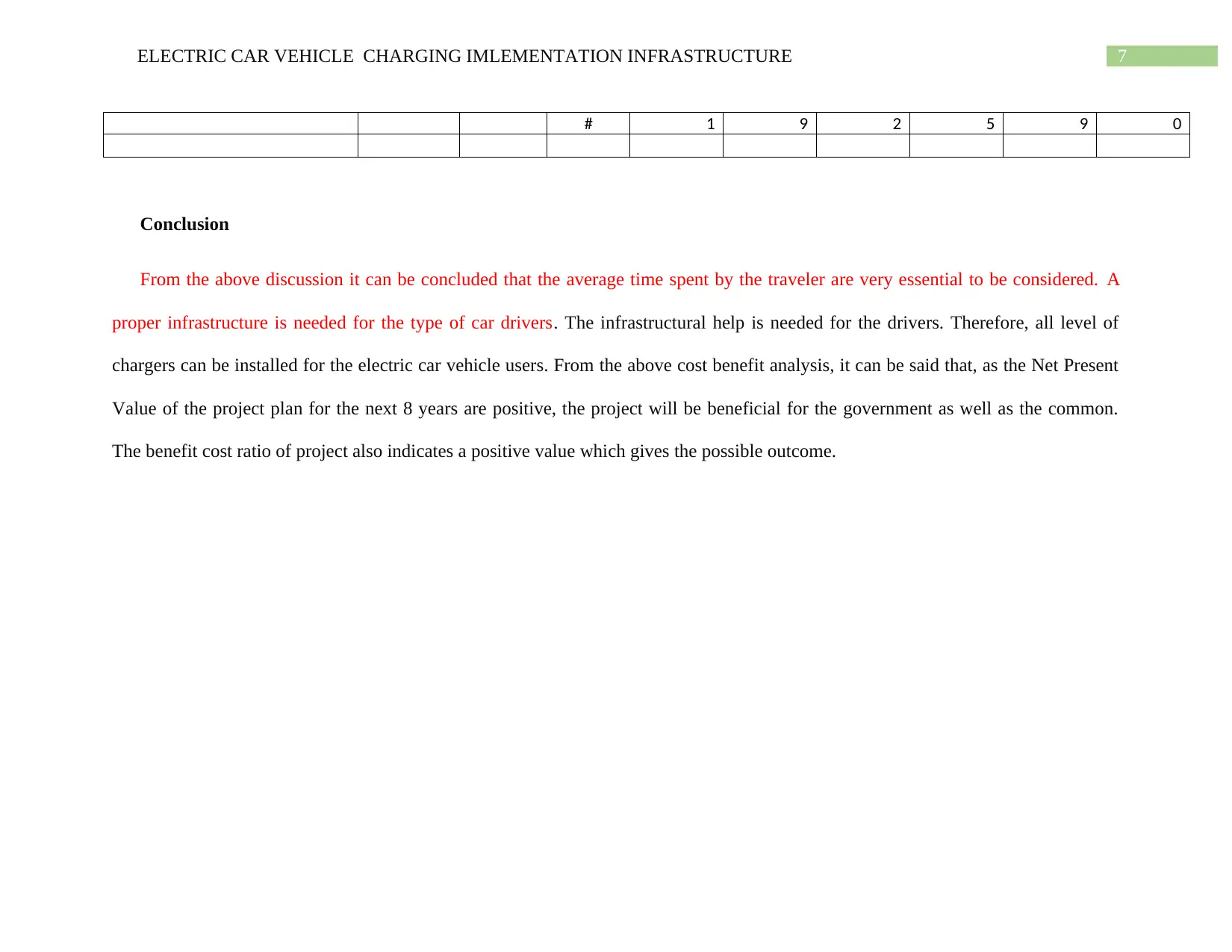
7ELECTRIC CAR VEHICLE CHARGING IMLEMENTATION INFRASTRUCTURE
# 1 9 2 5 9 0
Conclusion
From the above discussion it can be concluded that the average time spent by the traveler are very essential to be considered. A
proper infrastructure is needed for the type of car drivers. The infrastructural help is needed for the drivers. Therefore, all level of
chargers can be installed for the electric car vehicle users. From the above cost benefit analysis, it can be said that, as the Net Present
Value of the project plan for the next 8 years are positive, the project will be beneficial for the government as well as the common.
The benefit cost ratio of project also indicates a positive value which gives the possible outcome.
# 1 9 2 5 9 0
Conclusion
From the above discussion it can be concluded that the average time spent by the traveler are very essential to be considered. A
proper infrastructure is needed for the type of car drivers. The infrastructural help is needed for the drivers. Therefore, all level of
chargers can be installed for the electric car vehicle users. From the above cost benefit analysis, it can be said that, as the Net Present
Value of the project plan for the next 8 years are positive, the project will be beneficial for the government as well as the common.
The benefit cost ratio of project also indicates a positive value which gives the possible outcome.
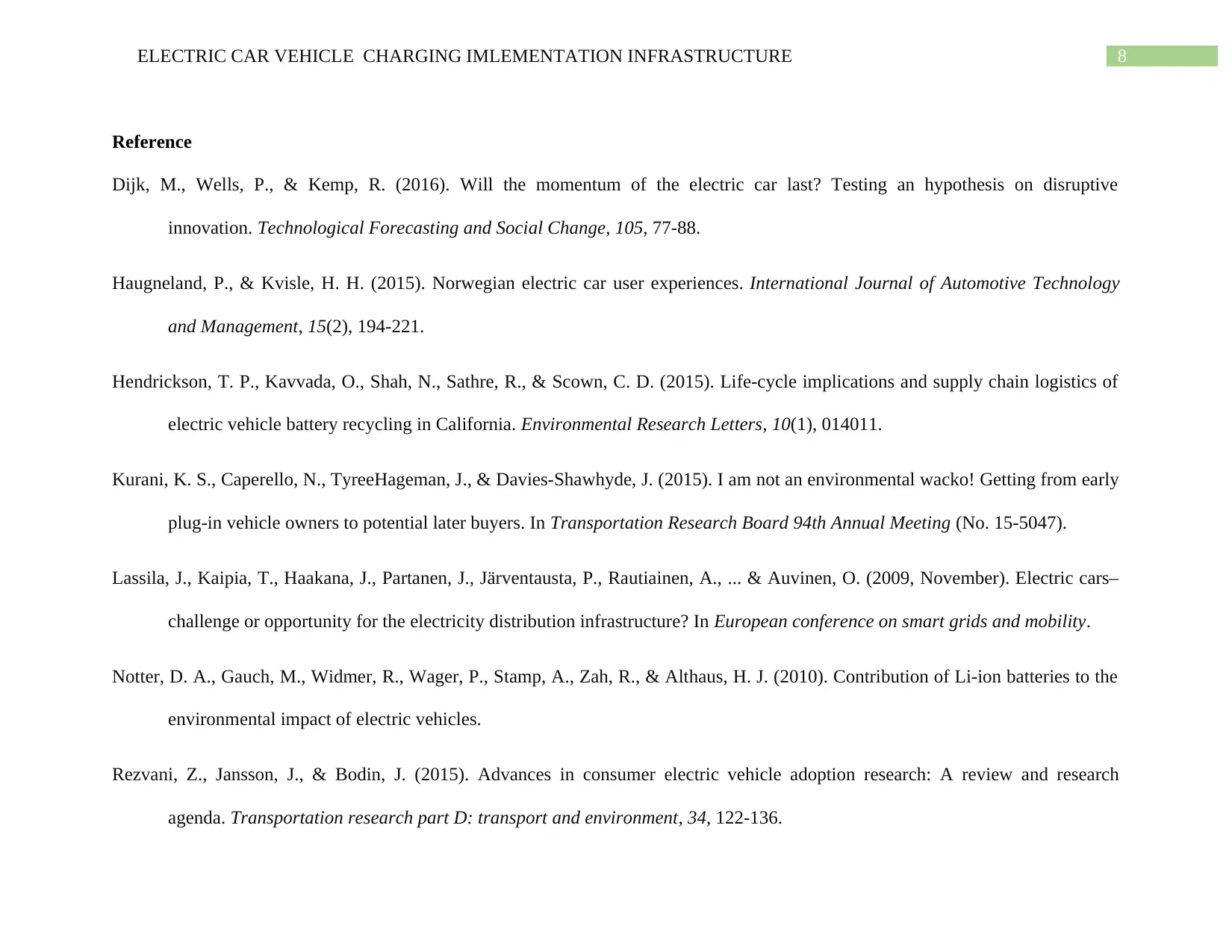
8ELECTRIC CAR VEHICLE CHARGING IMLEMENTATION INFRASTRUCTURE
Reference
Dijk, M., Wells, P., & Kemp, R. (2016). Will the momentum of the electric car last? Testing an hypothesis on disruptive
innovation. Technological Forecasting and Social Change, 105, 77-88.
Haugneland, P., & Kvisle, H. H. (2015). Norwegian electric car user experiences. International Journal of Automotive Technology
and Management, 15(2), 194-221.
Hendrickson, T. P., Kavvada, O., Shah, N., Sathre, R., & Scown, C. D. (2015). Life-cycle implications and supply chain logistics of
electric vehicle battery recycling in California. Environmental Research Letters, 10(1), 014011.
Kurani, K. S., Caperello, N., TyreeHageman, J., & Davies-Shawhyde, J. (2015). I am not an environmental wacko! Getting from early
plug-in vehicle owners to potential later buyers. In Transportation Research Board 94th Annual Meeting (No. 15-5047).
Lassila, J., Kaipia, T., Haakana, J., Partanen, J., Järventausta, P., Rautiainen, A., ... & Auvinen, O. (2009, November). Electric cars–
challenge or opportunity for the electricity distribution infrastructure? In European conference on smart grids and mobility.
Notter, D. A., Gauch, M., Widmer, R., Wager, P., Stamp, A., Zah, R., & Althaus, H. J. (2010). Contribution of Li-ion batteries to the
environmental impact of electric vehicles.
Rezvani, Z., Jansson, J., & Bodin, J. (2015). Advances in consumer electric vehicle adoption research: A review and research
agenda. Transportation research part D: transport and environment, 34, 122-136.
Reference
Dijk, M., Wells, P., & Kemp, R. (2016). Will the momentum of the electric car last? Testing an hypothesis on disruptive
innovation. Technological Forecasting and Social Change, 105, 77-88.
Haugneland, P., & Kvisle, H. H. (2015). Norwegian electric car user experiences. International Journal of Automotive Technology
and Management, 15(2), 194-221.
Hendrickson, T. P., Kavvada, O., Shah, N., Sathre, R., & Scown, C. D. (2015). Life-cycle implications and supply chain logistics of
electric vehicle battery recycling in California. Environmental Research Letters, 10(1), 014011.
Kurani, K. S., Caperello, N., TyreeHageman, J., & Davies-Shawhyde, J. (2015). I am not an environmental wacko! Getting from early
plug-in vehicle owners to potential later buyers. In Transportation Research Board 94th Annual Meeting (No. 15-5047).
Lassila, J., Kaipia, T., Haakana, J., Partanen, J., Järventausta, P., Rautiainen, A., ... & Auvinen, O. (2009, November). Electric cars–
challenge or opportunity for the electricity distribution infrastructure? In European conference on smart grids and mobility.
Notter, D. A., Gauch, M., Widmer, R., Wager, P., Stamp, A., Zah, R., & Althaus, H. J. (2010). Contribution of Li-ion batteries to the
environmental impact of electric vehicles.
Rezvani, Z., Jansson, J., & Bodin, J. (2015). Advances in consumer electric vehicle adoption research: A review and research
agenda. Transportation research part D: transport and environment, 34, 122-136.
⊘ This is a preview!⊘
Do you want full access?
Subscribe today to unlock all pages.

Trusted by 1+ million students worldwide
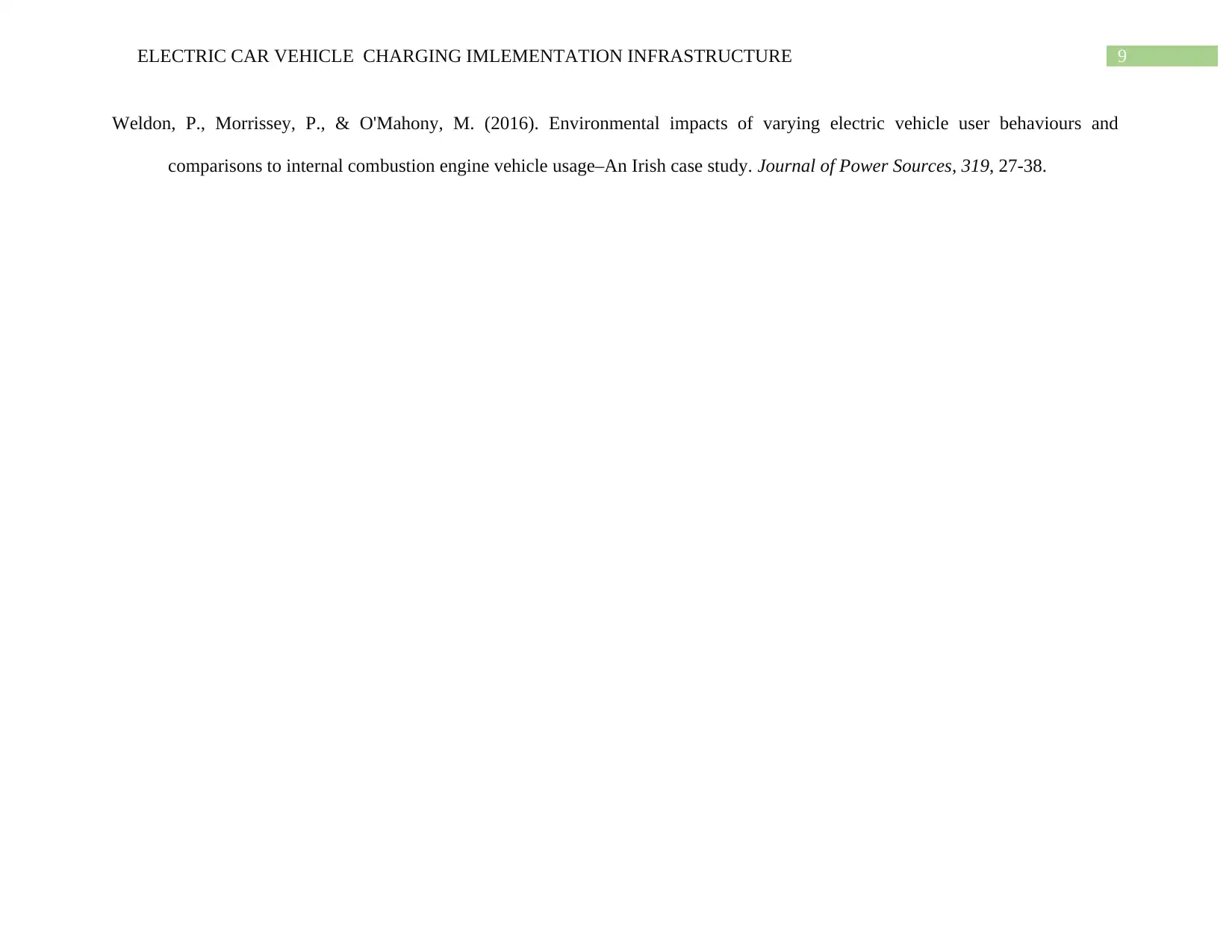
9ELECTRIC CAR VEHICLE CHARGING IMLEMENTATION INFRASTRUCTURE
Weldon, P., Morrissey, P., & O'Mahony, M. (2016). Environmental impacts of varying electric vehicle user behaviours and
comparisons to internal combustion engine vehicle usage–An Irish case study. Journal of Power Sources, 319, 27-38.
Weldon, P., Morrissey, P., & O'Mahony, M. (2016). Environmental impacts of varying electric vehicle user behaviours and
comparisons to internal combustion engine vehicle usage–An Irish case study. Journal of Power Sources, 319, 27-38.
1 out of 10
Related Documents
Your All-in-One AI-Powered Toolkit for Academic Success.
+13062052269
info@desklib.com
Available 24*7 on WhatsApp / Email
![[object Object]](/_next/static/media/star-bottom.7253800d.svg)
Unlock your academic potential
Copyright © 2020–2025 A2Z Services. All Rights Reserved. Developed and managed by ZUCOL.





